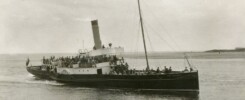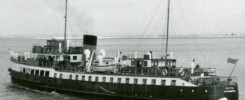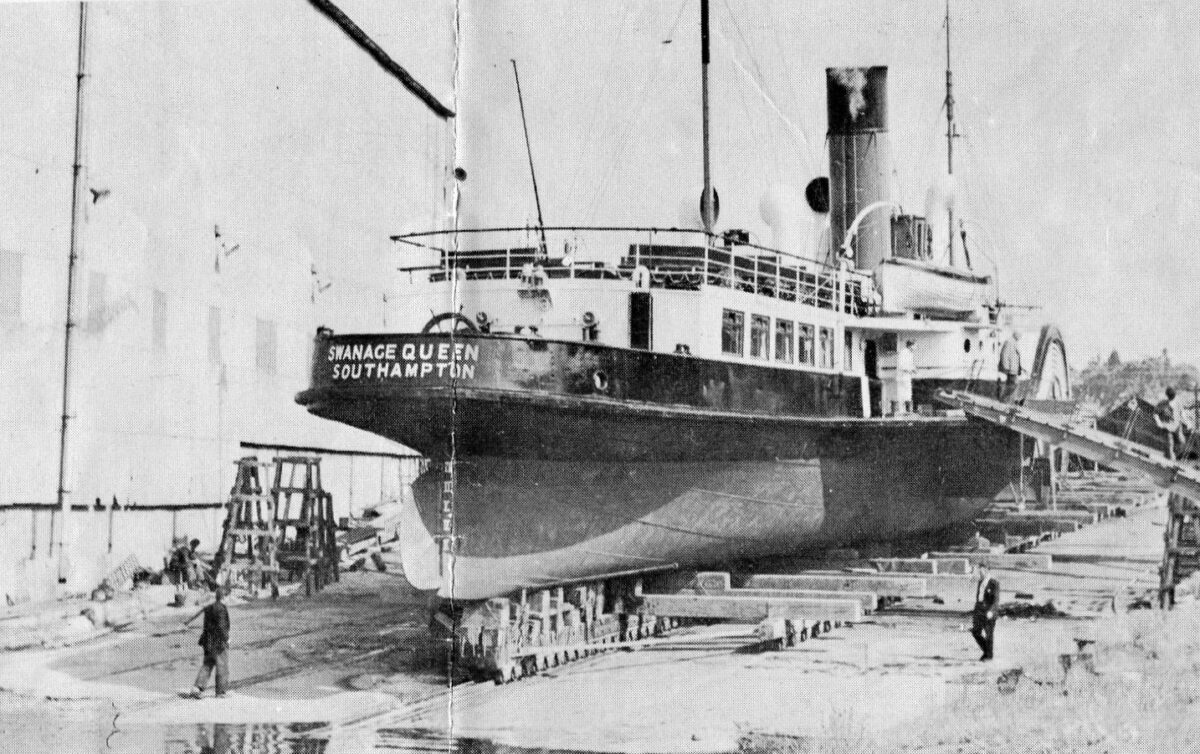
By Friday 16th February 1962 Captain Stuart M Townsend was the proud owner of the paddle steamer Swanage Queen then lying laid up at Topsham on the River Exe in Devon.
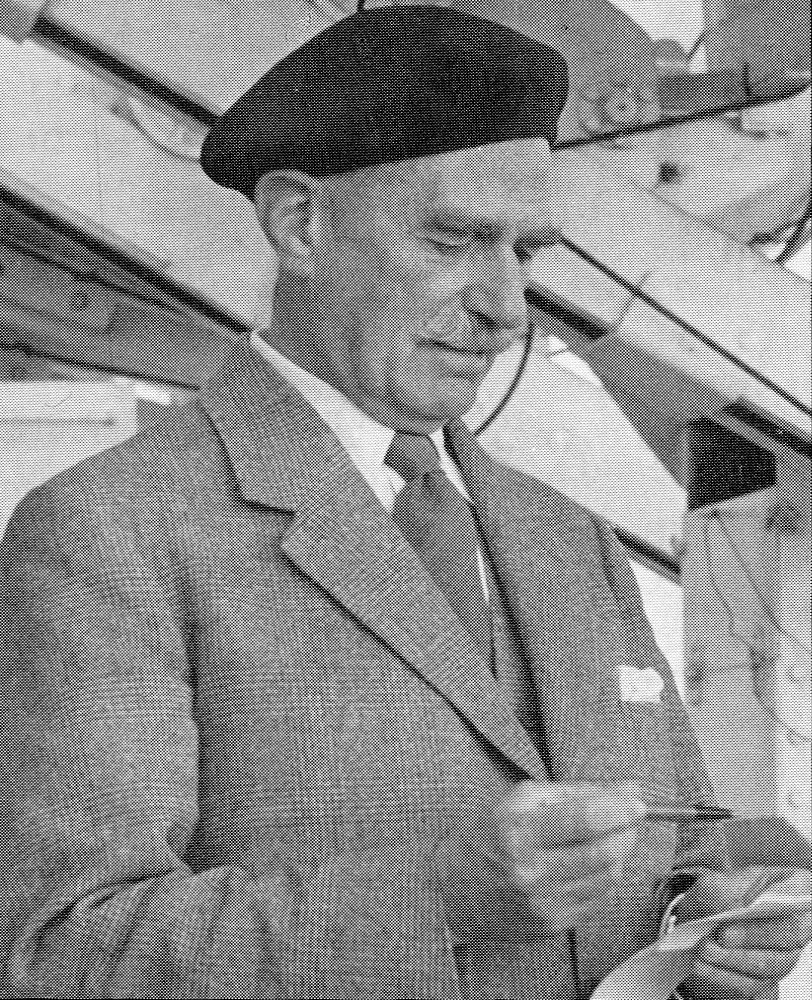
The family company Townsend Bros Shipping Ltd, which specialised in ship delivery and management, was already well established when Captain Stuart Townsend, then aged 40, put his toe in the water to try to inaugurate a cross Channel service for motorists between Dover and Calais in 1928. His intention was originally not to compete on any long term basis with the Southern Railway ships, which then had a monopoly on the service, but rather to undercut them in an effort to try to make them reduce their fares which as a regular continental motorist himself he thought were far too dear.
His service carrying cars in a small coaster proved an unexpected success. By 1930 he had invested in and converted a former Naval Town Class Minesweeper Forde to carry 307 passengers and 28 cars on the route and he was off with what became a highly profitable business.
After the Second World War he bought and converted the larger turbine driven former naval frigate Halladale. and she proved to be very profitable on into the 1950s. By 1956 Captain Townsend was thinking of expanding the business in order to bring in more new tonnage and planned to do this through a shares issue which he hoped would have great appeal to the ordinary man whose services with his low prices he was already targeting as his passengers.
Unfortunately his timing of this was not great coinciding as it did with the Suez Crisis. Share prices plummeted in the wake of the British invasion of Egypt. He woke up to find that he and his board had been taken over by a couple of aggressive young business men from the Midlands George Knott and Roland Wickenden who had bought loads of shares at knock down prices.
The sharp eyed amongst you will have already spotted that these two men also subsequently bought out P & A Campbell as part of their asset stripping strategy although in that case the losses in the paddle steamers were offset against the profits on the Dover Calais ferry service saving tax and thereby freeing up funds to build the first of their new Cross Channel roll on roll off car ferries Free Enterprise as well as giving P & A Campbell an unexpected Indian summer. But that is all another story for another day..
Back to Captain Townsend, he now found that he had lost control of his company. Wounded and not best pleased he retired to live in Sandbanks on the edge of Poole Harbour where he continued to take a passing interest in ships. In those days Sandbanks was not the playground of the rich which it has since become but nonetheless even then was a pretty upmarket sort of place to which to retire.
Not a million miles away in Bournemouth lived the also retired Captain Sydney Shippick founder of the New Medway Steam Packet Company and Managing Director until he himself retired back home to Poole in 1949. I find it inconceivable that they didn’t know each other. One of them had been the boss of a company running a cross Channel ferry from Dover to Calais. The other had been the boss of a company running cross Channel excursions from the Thames and Medway also to Calais and to other near continental ports. They must have known each other and have met over the years. Did they continue that relationship in Bournemouth? Were they close friends or did they hate the sight of each other?
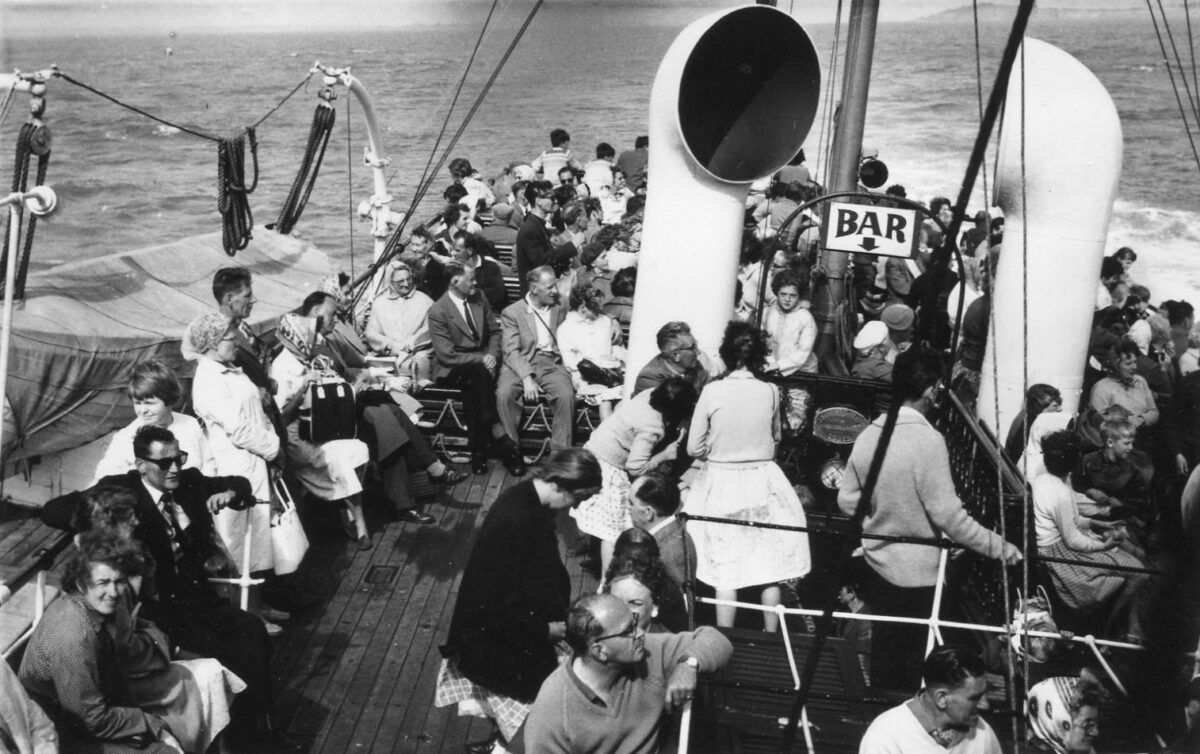
Captain Townsend would have been aware of Swanage Queen trying to compete with Cosens operating from Bournemouth and Swanage in 1961. He could not have missed seeing her her running past Sandbanks during that summer. And as a man with a keen interest in the current shipping scene he would have known about her owner Mr Jennings’s attempts to run her on the Sussex Coast from Brighton, Eastbourne and Hastings in 1960 and that previously she had been the railway ferry Freshwater operating between Lymington and Yarmouth.
In October 1961 with debts pressing in on all sides Mr Jennings put Swanage Queen up for sale. By February 1962 she had been bought by Sandbanks resident Captain Stuart Townsend.
Why did he do that? Of course the price was cheap and very affordable for a man of his substance. Maybe he just had a hankering and longing for getting back involved with ships once again and saw this as a way to do it. Maybe he was egged on by his friend from down the road Captain Shippick and others in the enthusiast community.
Of course all enthusiasts want to save paddle steamers. But sometimes there can be a gap between the dream and the technicalities of actually doing and funding it. I remember visiting PSPS founder Alan Robinson at his lovely home in Swanage in 2001 around the time that I was putting a new boiler into KC and him saying that back in the early days he had thought that the paddle steamers were just laid up each winter and then after a lick of paint started up again in the Spring. In retrospect he could laugh at this complete misreading of the situation.
Given his experience of shipping Captain Townsend would have understood the technicalities and costs of putting an elderly paddle steamer back into service so whatever his heart had been telling him when he bought her, when the reality of the associated costs had been assessed and the views of the Board of Trade taken into account then his head took a different view. In the end he sold Swanage Queen on for scrap in Belgium making a small profit on the deal in the doing of it. So the astute business brain was still there whirring around nicely in the background.
Swanage Queen arrived in the scrapyard in Belgium under tow in May just three months after this little glimmer of hope which had been lit about a new future for her in February had been blown out by the cold and stark winds of economic reality.
Tiny Point of Detail 1: Captain Jack Dawson joined Townsend’s ship delivery service just after the Second World War war and by a lucky chain of events found himself senior master with the firm within a couple of years sailing as captain of the Halladale. He remained senior master taking command of each of the new Free Enterprise ships in turn as they came into service over the years right up to his retirement in 1978.
When we first got KC going in 1985 I remember that he brought up coach parties of retired Dover officers more than once for our afternoon cruises. He came up onto the bridge and we had a chat. Clearly he was very proud of his long and successful career with Townsend. I also recall seeing him standing on deck just below my open wheelhouse window drinking a cup of coffee one day out of one of our nice blue and white willow pattern china cups. He looked up, smiled and said “I like to see a ship serving coffee in proper cups and saucers”.
Tiny Point of Detail 2: Joe Frame and Jim Nuttall were both Chief Engineers on the Halladale in the 1950s which they were able to do on their Second Engineer’s tickets because of the size of the ship. As larger ferries came into the fleet they were both caught in a cleft stick. They couldn’t any longer sail as Chief because the new ships were too big for that but they found that they couldn’t upgrade their Second’s tickets without leaving the company and going deep sea to get in the necessary qualifying sea time before they could take the exam for their Chief’s tickets. The company gave them no guarantee that they would be taken back on with Townsend again after that. They both thought about this and decided to stay as Second Engineers. But it must have been hard for them sailing as Second when they had been Chief with the company before.
After he retired around 1984 Joe became one of a small team of engineers who we recruited from Dover led by Maurice Marryatt and Harry Quirk to help on KC. Jim Nuttall also joined us later. All these men had a very positive approach and a very can do sort of attitude. They helped me enormously in those early stages of getting KC back into service and running her and for that I will be forever grateful.
Of them all Joe and Jim were particularly hands on and I remember them both quietly going about their business in the engine room making things work, fixing things if they went wrong and generally raising standards. And when on the controls both Joe and Jim were of that select band of engineers who knew how to make a paddle steamer engine dance. I never had any worries about Joe or Jim, or indeed Maurice or Harry, getting the engine stuck, giving wrong way engine movements or otherwise getting into a flap. All four had the required and golden touch on the levers.
Kingswear Castle returned to service in 2023 after the first part of a major rebuild which is designed to set her up for the next 25 years running on the River Dart. The Paddle Steamer Kingswear Castle Trust is now fund raising for the second phase of the rebuild. You can read more about the rebuilds and how you can help if you can here.
John Megoran
This article was first published on 16th February 2021.

